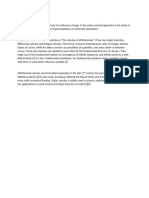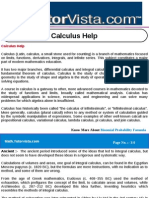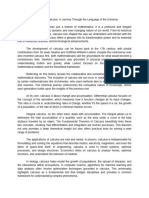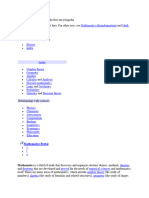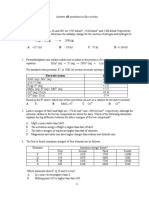0 ratings0% found this document useful (0 votes)
13 viewsCalculus, Originally Called Infinitesimal Calculus or "The Calculus of
Calculus, Originally Called Infinitesimal Calculus or "The Calculus of
Uploaded by
Chang DiThis document provides an overview of calculus, which is the mathematical study of continuous change and has two major branches: differential calculus concerns instantaneous rates of change, while integral calculus concerns accumulation of quantities. Calculus was developed independently in the late 17th century by Isaac Newton and Gottfried Leibniz and today has widespread uses in science, engineering, and economics. The word "calculus" comes from the Latin word meaning "small pebble" which were originally used for calculation.
Copyright:
© All Rights Reserved
Available Formats
Download as DOCX, PDF, TXT or read online from Scribd
Calculus, Originally Called Infinitesimal Calculus or "The Calculus of
Calculus, Originally Called Infinitesimal Calculus or "The Calculus of
Uploaded by
Chang Di0 ratings0% found this document useful (0 votes)
13 views1 pageThis document provides an overview of calculus, which is the mathematical study of continuous change and has two major branches: differential calculus concerns instantaneous rates of change, while integral calculus concerns accumulation of quantities. Calculus was developed independently in the late 17th century by Isaac Newton and Gottfried Leibniz and today has widespread uses in science, engineering, and economics. The word "calculus" comes from the Latin word meaning "small pebble" which were originally used for calculation.
Original Title
Calculus
Copyright
© © All Rights Reserved
Available Formats
DOCX, PDF, TXT or read online from Scribd
Share this document
Did you find this document useful?
Is this content inappropriate?
This document provides an overview of calculus, which is the mathematical study of continuous change and has two major branches: differential calculus concerns instantaneous rates of change, while integral calculus concerns accumulation of quantities. Calculus was developed independently in the late 17th century by Isaac Newton and Gottfried Leibniz and today has widespread uses in science, engineering, and economics. The word "calculus" comes from the Latin word meaning "small pebble" which were originally used for calculation.
Copyright:
© All Rights Reserved
Available Formats
Download as DOCX, PDF, TXT or read online from Scribd
Download as docx, pdf, or txt
0 ratings0% found this document useful (0 votes)
13 views1 pageCalculus, Originally Called Infinitesimal Calculus or "The Calculus of
Calculus, Originally Called Infinitesimal Calculus or "The Calculus of
Uploaded by
Chang DiThis document provides an overview of calculus, which is the mathematical study of continuous change and has two major branches: differential calculus concerns instantaneous rates of change, while integral calculus concerns accumulation of quantities. Calculus was developed independently in the late 17th century by Isaac Newton and Gottfried Leibniz and today has widespread uses in science, engineering, and economics. The word "calculus" comes from the Latin word meaning "small pebble" which were originally used for calculation.
Copyright:
© All Rights Reserved
Available Formats
Download as DOCX, PDF, TXT or read online from Scribd
Download as docx, pdf, or txt
You are on page 1of 1
This article is about the branch of mathematics.
For other uses, see Calculus
(disambiguation).
Calculus, originally called infinitesimal calculus or "the calculus of infinitesimals", is
the mathematical study of continuous change, in the same way that geometry is the
study of shape and algebra is the study of generalizations of arithmetic operations.
It has two major branches, differential calculus and integral calculus; the former concerns
instantaneous rates of change, and the slopes of curves, while integral calculus concerns
accumulation of quantities, and areas under or between curves. These two branches are
related to each other by the fundamental theorem of calculus, and they make use of the
fundamental notions of convergence of infinite sequences and infinite series to a well-
defined limit.[1]
Infinitesimal calculus was developed independently in the late 17th century by Isaac
Newton and Gottfried Wilhelm Leibniz.[2][3] Today, calculus has widespread uses
in science, engineering, and economics.[4]
In mathematics education, calculus denotes courses of elementary mathematical
analysis, which are mainly devoted to the study of functions and limits. The
word calculus (plural calculi) is a Latin word, meaning originally "small pebble" (this
meaning is kept in medicine – see Calculus (medicine)). Because such pebbles were
used for calculation, the meaning of the word has evolved and today usually means a
method of computation. It is therefore used for naming specific methods of calculation
and related theories, such as propositional calculus, Ricci calculus, calculus of
variations, lambda calculus, and process calculus.
You might also like
- Linear Algebra For Computational Sciences and Engineering - Ferrante Neri (Springer, 2016)Document472 pagesLinear Algebra For Computational Sciences and Engineering - Ferrante Neri (Springer, 2016)Yannick AssoumanNo ratings yet
- CalculusDocument1 pageCalculusEdison BatulaNo ratings yet
- Calculus - What IsDocument1 pageCalculus - What IszidaaanNo ratings yet
- CalculusDocument1 pageCalculusrijoiNo ratings yet
- CALCULUSDocument1 pageCALCULUSCassandra UyNo ratings yet
- CalculusDocument2 pagesCalculusJimmy TengNo ratings yet
- Basic of 'Calculus'Document3 pagesBasic of 'Calculus'Jazib AsgharNo ratings yet
- Calculus Wps OfficeDocument12 pagesCalculus Wps Officecanoysannajane14No ratings yet
- Week 001 Fundamental of CalculusDocument7 pagesWeek 001 Fundamental of CalculusChristalynNo ratings yet
- 1 Architecture and Engineering Heavily Relies On Calculus For The Construction of Bridges, Road, Tunnel EtcDocument2 pages1 Architecture and Engineering Heavily Relies On Calculus For The Construction of Bridges, Road, Tunnel EtcSherida GibbsNo ratings yet
- Enriquez Nicholas OriginsDocument6 pagesEnriquez Nicholas OriginsMiguel EnriquezNo ratings yet
- Calculus: HistoryDocument5 pagesCalculus: HistoryMikel NinalgaNo ratings yet
- Calculus HelpDocument4 pagesCalculus Helpapi-140032165No ratings yet
- Reflection On CalculusDocument2 pagesReflection On Calculusallysapagsanghan.ce2No ratings yet
- Calculus - Wikipedia, The Free EncyclopediaDocument14 pagesCalculus - Wikipedia, The Free EncyclopediahlkjhlkjhlhkjNo ratings yet
- Calculus: HistoryDocument13 pagesCalculus: HistoryAbhay KatiyarNo ratings yet
- CalculusDocument166 pagesCalculusCris SosaNo ratings yet
- KibsDocument4 pagesKibsReymondNo ratings yet
- CalculusDocument2 pagesCalculuspupusiakajusiaNo ratings yet
- Intro PBLDocument1 pageIntro PBLAriff ShasteraNo ratings yet
- Different Meanings of "Algebra"Document6 pagesDifferent Meanings of "Algebra"Ariel GonzalesNo ratings yet
- History: AncientDocument39 pagesHistory: AncientWenefredoDeAsisAspillaJr.100% (1)
- CalculusDocument2 pagesCalculuslinyoplay09809No ratings yet
- Mathematical AnalysisDocument11 pagesMathematical AnalysisjosgauNo ratings yet
- CalculusDocument20 pagesCalculusRath PershNo ratings yet
- Mathematics PortalDocument10 pagesMathematics PortalannirmalaNo ratings yet
- The History of The Concept of Function and Some Educational ImplicationsDocument9 pagesThe History of The Concept of Function and Some Educational ImplicationsMahmoud BouazizNo ratings yet
- Integral - 56Document23 pagesIntegral - 56hudaahhu49No ratings yet
- Calculus: Part of A Series of Articles AboutDocument4 pagesCalculus: Part of A Series of Articles AboutJefferson Nolty GenoviaNo ratings yet
- Linear Algebra For Computational EngineeringDocument21 pagesLinear Algebra For Computational EngineeringCovenant AdeogoNo ratings yet
- Newton CalculusDocument4 pagesNewton CalculusNoor Suhaida CNo ratings yet
- Algebra: Jump To Navigationjump To SearchDocument5 pagesAlgebra: Jump To Navigationjump To SearchLiborio MejíaNo ratings yet
- 92 Ponte (Functions)Document16 pages92 Ponte (Functions)Gary CasperNo ratings yet
- 9Document3 pages9nexep85917No ratings yet
- Application of Differential CalculusDocument4 pagesApplication of Differential Calculustutorciecle123No ratings yet
- What Is CalculusDocument4 pagesWhat Is CalculusLuis UmanzorNo ratings yet
- IntegralDocument27 pagesIntegralalexandra deanNo ratings yet
- 12th Grade MathDocument4 pages12th Grade Mathcircleteam123No ratings yet
- Mathematics Introduction For MSCDocument52 pagesMathematics Introduction For MSC34plt34No ratings yet
- CalculusDocument2 pagesCalculushogr6722No ratings yet
- ReportDocument7 pagesReportDebanjali MajumderNo ratings yet
- TH THDocument1 pageTH THsrirampratap2401No ratings yet
- Differentiation and Its ApplicationDocument76 pagesDifferentiation and Its ApplicationAbbey PaulNo ratings yet
- C Is A: Mathematics Richard Courant Herbert Robbins England Oxford University PressDocument3 pagesC Is A: Mathematics Richard Courant Herbert Robbins England Oxford University PressAudrey AlundayNo ratings yet
- MathDocument1 pageMathKevin OinezaNo ratings yet
- Integral: Definite Integrals, Which Can Be Interpreted FormallyDocument22 pagesIntegral: Definite Integrals, Which Can Be Interpreted FormallyNirmal BhowmickNo ratings yet
- JJJJJJDocument3 pagesJJJJJJRakibul IslamNo ratings yet
- Business Calculus PDFDocument2 pagesBusiness Calculus PDFJeffreyBeridaNo ratings yet
- Integral - WikipediaDocument23 pagesIntegral - WikipediaDavid SandersNo ratings yet
- Algebra: "Algebraist" Redirects Here. For The Novel by Iain M. Banks, See - For Beginner's Introduction To Algebra, SeeDocument12 pagesAlgebra: "Algebraist" Redirects Here. For The Novel by Iain M. Banks, See - For Beginner's Introduction To Algebra, SeeEduardo DíazNo ratings yet
- AlgebraDocument14 pagesAlgebraRengeline LucasNo ratings yet
- Chapter 05Document13 pagesChapter 05reyhankadriNo ratings yet
- History: Mathematical Analysis, Which Mathematicians Refer To Simply As Analysis, Has ItsDocument5 pagesHistory: Mathematical Analysis, Which Mathematicians Refer To Simply As Analysis, Has Itsashi1564No ratings yet
- Combinatorics: Combinatorics Is An Area of Mathematics Primarily Concerned With Counting, Both As A Means and An EndDocument9 pagesCombinatorics: Combinatorics Is An Area of Mathematics Primarily Concerned With Counting, Both As A Means and An EndK. M. Junayed AhmedNo ratings yet
- Algebra (FromDocument11 pagesAlgebra (From123sanchezNo ratings yet
- Calculus Essay WritingDocument4 pagesCalculus Essay Writingapi-328401829No ratings yet
- Topic - MAthematicsDocument21 pagesTopic - MAthematicsAG05 Caperiña, Marcy Joy T.No ratings yet
- Mathematical AnalysisDocument24 pagesMathematical AnalysisSire MonNo ratings yet
- The Calabi–Yau Landscape: From Geometry, to Physics, to Machine LearningFrom EverandThe Calabi–Yau Landscape: From Geometry, to Physics, to Machine LearningNo ratings yet
- Assignment 5Document4 pagesAssignment 5Chang DiNo ratings yet
- Chap 8 Part 1Document14 pagesChap 8 Part 1Chang DiNo ratings yet
- CadmiumDocument1 pageCadmiumChang DiNo ratings yet
- Assignment 3Document9 pagesAssignment 3Chang DiNo ratings yet
- The Chinese Competitive GameDocument1 pageThe Chinese Competitive GameChang DiNo ratings yet
- FrictionDocument1 pageFrictionChang DiNo ratings yet
- Football Is A Family ofDocument1 pageFootball Is A Family ofChang DiNo ratings yet
- Association FootballDocument1 pageAssociation FootballChang DiNo ratings yet
- Football HistoryDocument1 pageFootball HistoryChang DiNo ratings yet
- Pls Learn The Topic. Any Question Can Ask Me Later. Copy The Notes. and Ans Tne Question - Later Will Show The AnsDocument2 pagesPls Learn The Topic. Any Question Can Ask Me Later. Copy The Notes. and Ans Tne Question - Later Will Show The AnsChang DiNo ratings yet
- Learning Outcome:: Example 2Document6 pagesLearning Outcome:: Example 2Chang DiNo ratings yet
- Answer All Questions in This Section: Electrode System EDocument9 pagesAnswer All Questions in This Section: Electrode System EChang DiNo ratings yet
- 2015-2-NS-ST Paul-ADocument4 pages2015-2-NS-ST Paul-AChang DiNo ratings yet
- Lim 3 3 X: 2019-2-PAH-STATE Section A (45 Marks)Document3 pagesLim 3 3 X: 2019-2-PAH-STATE Section A (45 Marks)Chang DiNo ratings yet

